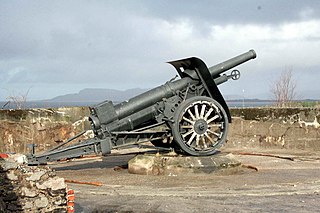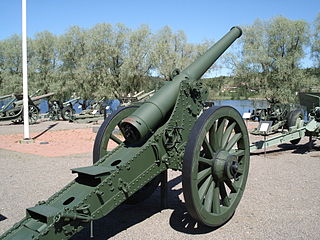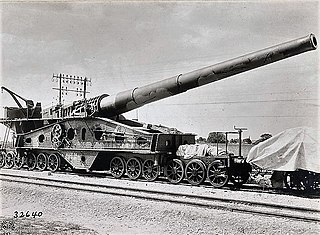
The French 75 mm field gun was a quick-firing field artillery piece adopted in March 1898. Its official French designation was: Matériel de 75mm Mle 1897. It was commonly known as the French 75, simply the 75 and Soixante-Quinze. The French 75 was designed as an anti-personnel weapon system for delivering large volumes of time-fused shrapnel shells on enemy troops advancing in the open. After 1915 and the onset of trench warfare, other types of battlefield missions demanding impact-detonated high-explosive shells prevailed. By 1918 the 75s became the main agents of delivery for toxic gas shells. The 75s also became widely used as truck mounted anti-aircraft artillery. They were also the main armament of the Saint-Chamond tank in 1918.

The Canon de 155 C modèle 1917 Schneider, often abbreviated as the C17S, was a French howitzer designed by Schneider. It was essentially the Canon de 155 C modèle 1915 Schneider fitted with a different breech to use bagged propellant rather than the cartridge cases used by the older howitzer. It was used by France, Russian Empire, Belgium, Rumania, and the United States from 1917 during World War I and was widely exported after the war. Surviving weapons were in service with France, Poland, Greece, Italy, Belgium, the United States, and Finland during World War II. Captured weapons were used by the Germans for their 2nd-line artillery and coast defense units.

The Canon de 194 GPF - was the first French tracked self-propelled gun (SPG). Designed at the end of World War I, it was a pioneering weapon with many modern features.

The Canon de 138 mm Modèle 1910 was a medium calibre naval gun of the French Navy used during World War I and World War II. It was carried by the dreadnoughts of the Courbet and Bretagne classes as their secondary armament and planned for use in the Normandie-class battleships. It was used as the primary armament for the Arras-class sloops and planned for the La Motte-Picquet-class cruisers that was cancelled in 1915. It was also used in coast defense batteries during both World Wars.

The Canon de 155 C modèle 1915 Saint-Chamond was a French howitzer used during World War I. It was based on a private prototype of a 150 millimetres (5.9 in) howitzer presented to the Mexican government in 1911. The French government ordered 400 Saint-Chamond howitzers in 1915, these being delivered starting in late 1916. Small numbers of Saint-Chamond howitzers were given to the Serbian and Romanian armies towards the end of World War I. The Saint-Chamond howitzer served in the French Army after World War I and were mobilised at the outbreak of World War II. Finland bought 24 Saint-Chamond howitzers during the Winter War and these served until the 1960s. The German Army captured some Saint-Chamond howitzers after the fall of France and used these mostly as coastal defence guns until the end of World War II.

The 152 mm howitzer Model 1910 Schneider or, more properly, 6 dm polevaja gaubitsa sistemy Schneidera as it was designated in Tsarist times, was a French howitzer designed by Schneider et Cie. It was used by the Russian Empire and the Soviet Union during World War I, the Russo-Polish War and the Russian Civil War. Finland captured nine during the Finnish Civil War, but did not use them during that conflict. They did see combat during the Winter War and the Continuation War.

The Canon de 240 mm L modèle 1884 was a heavy artillery piece originally employed as coastal artillery and later converted to siege artillery and railway artillery roles. Mle 1884 guns were used in both World War I and World War II.

The de Bange 155 mm long cannon mle. 1877 was the French artillery piece that debuted the 155 mm caliber in widespread use today. Although obsolete by the beginning of World War I, the 155 L was nonetheless pressed into service and became the main counter-battery piece of the French army in the first two years of the war.

Canon de 145 L modèle 1916 Saint-Chamond or L 16 St Ch was a French heavy artillery piece designed and produced during the First World War. A number were still on hand during the Second World War and served as coastal artillery in the French and German services.

The Canon de 155 L Modele 1917 Schneider was a French heavy artillery piece designed and produced during the First World War. A number were still on hand during the Second World War and served in Belgian, French and German service.

The Canon de 155 L modèle 1918 Schneider was a French heavy artillery piece designed and produced during the First World War. A number were still on hand during the Second World War and served in French and German service.

The Canon de 155 L modèle 1877/14 Schneider was a French heavy artillery piece designed before and produced during the First World War. A number were still on hand during the Second World War and served in the French and German services.

The Obusier de 400 Modèle 1915/1916 were French Railroad Howitzers that saw action during the First World War and Second World Wars. The mle 1915/1916 was the largest caliber Railroad Howitzers in service with the French Army during the First World War.

The Canon de 120 mm L modèle 1878 – was a French piece of siege and field artillery which was widely used during the First World War and despite its obsolescence, it was still in use by some nations during the Second World War.

The Canon de 240 modèle 93/96TAZ was a French Coastal Defense and Railway gun used by the French Army during World War I and by the German Army during World War II.

The Canon de 32 modèle 1870/93 à glissement was a French Railway gun used by the French Army during World War I and World War II.

The Canon de 340 modèle 1912 à berceau was a French railway gun used by the French Army and the United States Army during World War I. The guns were used again by the French Army during World War II.

The Canon de 305 modèle 1893/96 à glissement was a French railway gun that saw action during World War I. These guns were rebored late in the war and held in reserve between the wars then mobilized by France during World War II.

The Canon de 32 modèle 1870/81 à glissement was a French Railway gun used by the French Army during World War I and World War II.




















